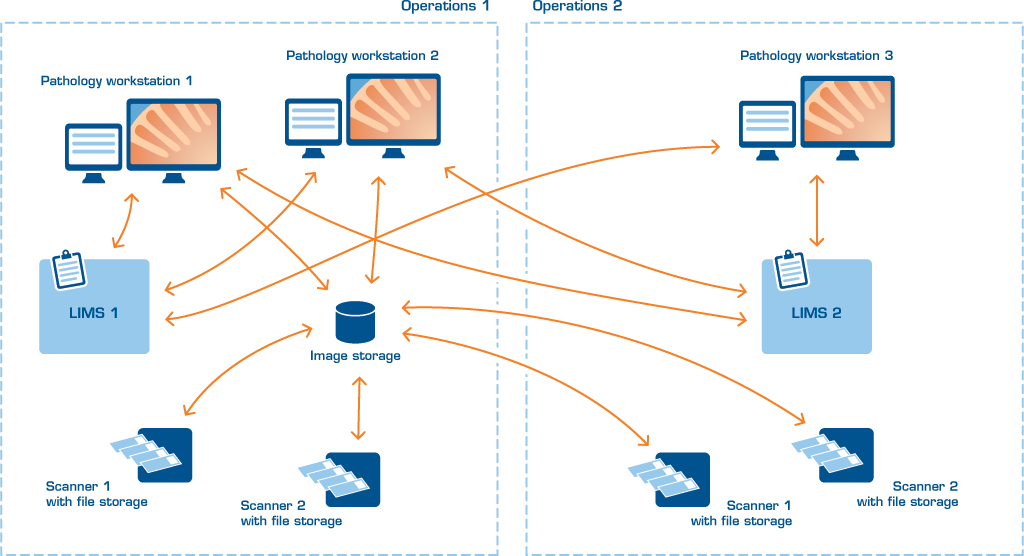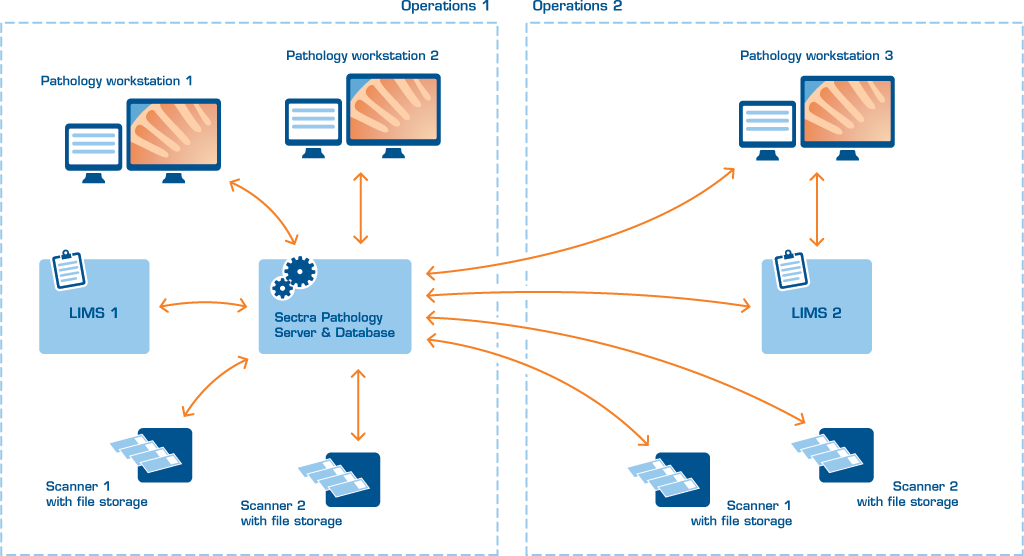Pathology, a labor-intense and historically heavily analogue discipline, is now undergoing digitization. Departments are investing in scanners for the digitization of images and pathologists are adapting to reviewing images on monitors instead of under microscopes. The full adaptation to digital technology will take time and be incremental, but based on our experience from the digitization of radiology and mammography, Sectra has the knowledge to ensure the journey goes smoothly.
When you purchase the hardware, i.e. a scanner, a viewer is included. This viewer has been adapted to be compatible with the image format of the scanner in question and can be used for reviews, conducting distance or area measurements or making annotations. Images are typically stored on a file share, close to the scanner, before being discarded or moved to a long-term archive within the hospital IT department.
No standard image file format has yet been applied, which means that the viewer that comes with the scanner works as long as the pathologist is only interested in reviewing images produced by scanners from a single vendor. It also works as long as there is no need to look at images from other disciplines or pathology images located at other hospitals. Scanner vendors are typically experts in hardware and not in making robust viewers that are able to display various image formats and ensure good performance without downtime. They are optimized for the proprietary file format and function well in the initial stages of the digitization process, but fail as the workflow becomes more complex. Sectra recognizes this discussion from the early days of the digitization of radiology, where we now see a clear disconnection between software and hardware vendors, as a best-of-breed strategy has been shown to be the most beneficial for the users.
It is expected that within a single department, different scanners will be used for different purposes. One vendor may have the best high-throughput scanner for general histology, while another scanner is best for large or mega slides and yet another for cytology or fluorescence staining. This means that for a full-scale primary diagnostic workflow, the scanner viewer will most likely not be sufficient. There will be a need for a hardware-neutral workstation that supports the immediate display of images regardless of file format. Furthermore, as digital pathology opens the door for a higher degree of collaboration between hospitals when it comes to sharing cases and accessing advice and consultancy services from different specialties, there will also be an increased need for a solution where access to images is not tied to the current location.
Sectra Digital Pathology Solution is more than just a viewer. The image window per se has the same functionalities as a typical scanner viewer, with possibilities, for example, to perform measurements and annotations. The important difference lies behind that the image window, in the backend infrastructure. Based on the Sectra PACS, which has been used in radiology for more than 20 years, Sectra Digital Pathology Solution is an enterprise-wide IT solution with central storage for all images produced in the department—or even hospital—which grants access to images from wherever you are, whenever you want, based on access rights. In the Sectra Digital Pathology Workstation, the pathologist can access patient information and records, including a full image history and images of the current case, as well as a reporting module. Sectra Digital Pathology Solutions also supports the preparation and execution of tumor boards, as well as assisting the pathologist in education preparation. With a track record of an uptime of more than 99.99%, you can always trust that iy will be available, resulting in higher productivity and throughput.
Having the possibility to perform all daily tasks from a single workstation, not tied to a dedicated computer or brand of scanner, ensures access to images instantly. Sectra Digital Pathology Solutions is vendor neutral and designed to give the pathologist tools to achieve a better result than using a microscope, resulting higher quality reports in less time per case.


